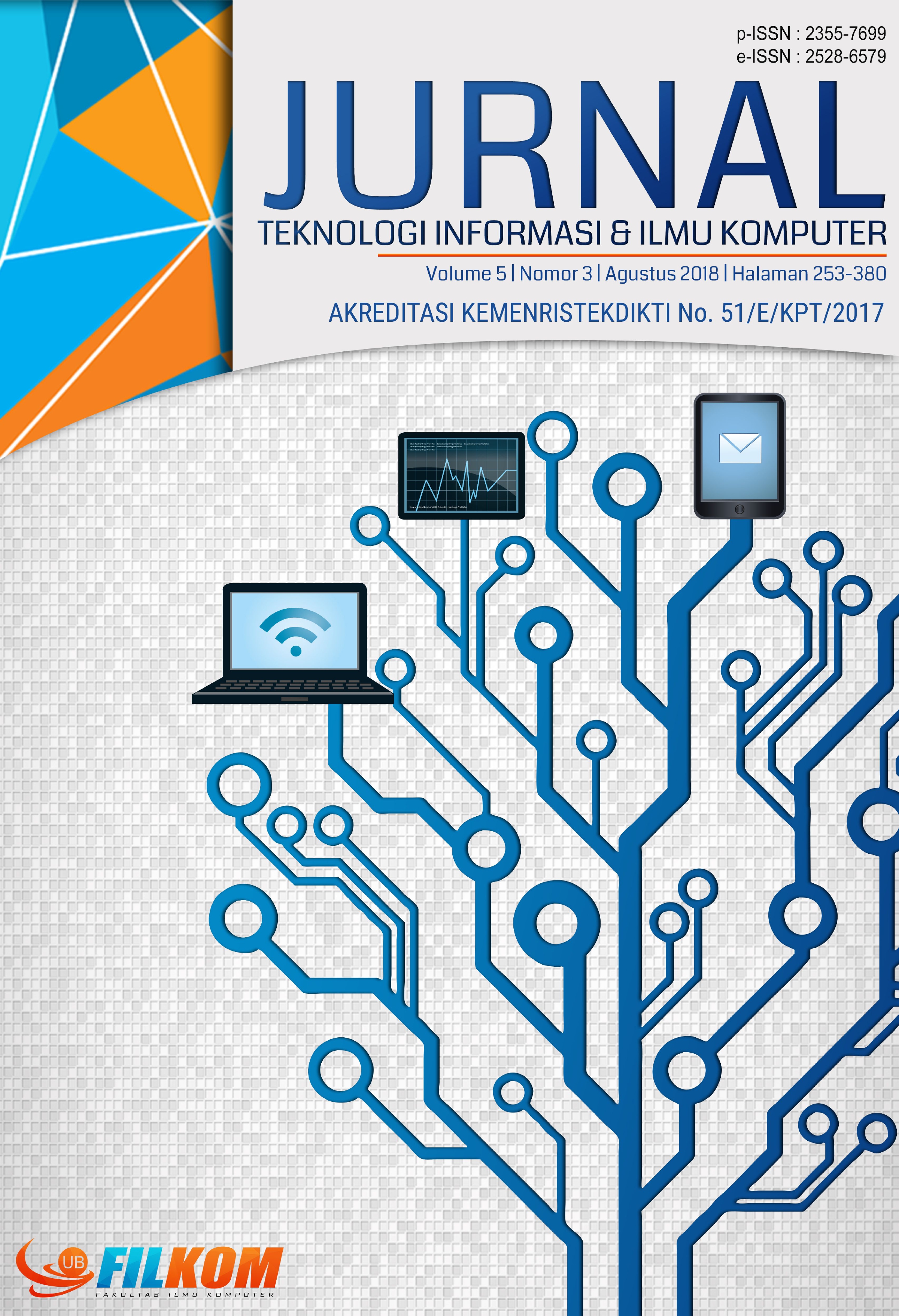Rancang Bangun Chatbot Pembelajaran Java pada Google Classroom dan Facebook Messenger
DOI:
https://doi.org/10.25126/jtiik.201853837Kata Kunci:
google classroom, facebook messenger, chatbot, java, organizing exercise items.Abstrak
Aplikasi kelas onlinetelah diterapkan di SMK Telkom Malang menggunakan platformGoogleClassroompada mata pelajaran Pemrograman Berorientasi Objek (PBO). Penggunaan Google Classroompada mata pelajaran PBO ditambahkan materi chatbotpembelajaran Javadari Oracle Academy Java FoundationmenggunakanplatformFacebook Messengersebagai media untuk membantu Guru dalam menyediakan materi kepada siswa diantaranya adalah materi dasar pemrograman Java dan penyajian item soal kuis. Pada model kuis yang disajikan chatbotini, antar siswa mendapat respon penyajian item soal yang berbeda dalam pengerjaan kuis tentang materi yang ditampilkan sesuai dengan scoretingkat kesulitan soal yang dikerjakan oleh siswa dengan metode Organizing Exercise Items. Pada hasil ujicoba, chatbotdapat memberikan semua respon dengan tepat kepada seluruh siswa yaitu tentang penyajian item soal dengan topik materi Java Software Developmentsesuai tingkat kesulitan yang berbeda yaitu mudah, sedang dan sulit. Dengan demikian siswa dinyatakan dapat berinteraksi dengan chatbotsebagai media belajar yang dapat membantu guru dalam memberikan fasilitas belajar kepada siswa sesuai tingkat pemahaman materi soal pada pembelajaran Java. Adanya chatbotyang dibangun diharapkan dapat memberikan solusi kepada guru serta berkontribusi positif saat proses pembelajaran oleh siswa yang diintegrasikan pada kelas onlinetanpa batasan ruang, waktu dan jumlah siswa.
Abstract
Online class application has been applied in SMK Telkom Malang using Google Classroom platform on Object Oriented Programming subjects (OOP). Google Classroom on PBO subjects added Java learning chatbot material from the Oracle Academy Java Foundation using the Messenger Facebook platform. Both of these learning media can help teachers in providing materials to students such as basic Java programming materials and the presentation of items about the quiz. In the quiz model that is presented by this chatbot, the students get responses of different items in the quiz about the material that is displayed in accordance with the score of the difficulty level of the problems done by the students by the Organizing Exercise Items method. In the test results, chatbot is applied to the learning of 3 classes and creating a higher final exam results with an average difference of 0.60 points from the conventional learning group. In the learning results there is also an increase in the value of post test of 0.39 points from the first test. Thus the students can interact with chatbot as a learning medium Java programming language and Chatbot can help teachers in the provision of materials and quizzes. And result of effectiveness test through ISO 9126 software quality test some aspect gets predicate very feasible to applied.
Downloads
Referensi
ALENCAR, M. & NETTO, J.M., 2011. Improving Cooperation in Virtual Learning Environments Using Multi-Agent Systems and AIML. IEEE.
A.S., ROSA & SHALAHUDIN, M., 2013. Rekayasa Perangkat Lunak Terstruktur Dan Berorientasi Objek. Bandung: Informatika.
ATHIRA P. M., SREEJA M. & P. C. REGHURAJ., 2013. Architecture of an Ontology-Based Domain-Specific Natural Language Question Answering System. International Journal of Web & Semantic Technology (IJWesT). Vol.4: 4.
BAITI, Z.N. & NUGROHO, F., 2013. Aplikasi Chatbot MI3 untuk Informasi Jurusan Teknik Informatika Berbasis Sistem Pakar Menggunakan Metode Forward Chaining. Malang: UIN Maulana Malik Ibrahim Malang.
HOSANEE, Y. & PANCHOO, S., 2015. An Enhanced Software Tool to Aid Novices in Learning Object Oriented. IEEE.
IFTAKHAR, S., 2016. Google Classroom: What Works and How?. Journal of Education and Social Sciences, Vol. 3.
KINCAID, R. & POLLOCK, G., 2017. Nicky: Toward A Virtual Assistant for Test and Measurement Instrument Recommendations. IEEE.
MADHU, D., JAIN, N., SEBASTIAN, E., SHAJI, S. & AJAYAKUMAR, A., 2017. A Novel Approach for Medical Assistance Using Trained Chatbot. IEEE.
MORALES, M.L., GONZALES, J.J. & JUAREZ, R.F., 2012. Emotional Dialogue in a Virtual Tutor for Educational Software. Research in Computing Science 56: 19-27.
PATIL, A., MARIMUTHU, K, RAO, N. & NIRANCHANA, R., 2017. Comparative study of cloud platforms to develop a Chatbot. International Journal of Engineering & Technology. 6 (3): 57-61.
PRESSMAN, R.S. & MAXIM, B.R., 2015. Software Engineering: A Practitioner’s Approach 8th Edition. NY: McGraw-Hill.
SHAIKH, A.M.A. & KARALA, Y., 2017. Artificial Intelligence(Chat BoT’s). International Journal of Scientific & Engineering Research. Volume 8: Issue 2.
SOPHAN, M.K. & Kurniawati, A., 2018. Perancangan Aplikasi Learning by Doing Interaktif untuk Mendukung Pembelajaran Bahasa Pemrograman. JTIIK.
SWETA P. LENDE & DR.M.M. RAGHUWANSHI, 2016. Question Answering System on Education Acts Using NLP Techniques. IEEE.
TANWAR, P., PRASAD, T.V. & DATTA, K., 2014. An Effective Reasoning Algorithm for Question Answering System. Ijacsa.
VUKOVIC, D.R. & DUJLOVIC, I.M., 2016. Facebook Messenger Bots and Their Application for Business. IEEE.
WIDJAJANTI., K., SAROSA, M. & KUSUMAWARDHANI, M., 2015. Organizing Exercise Items in Mathematics Learning. IJSR.
Unduhan
Diterbitkan
Terbitan
Bagian
Lisensi

Artikel ini berlisensi Creative Common Attribution-ShareAlike 4.0 International (CC BY-SA 4.0)
Penulis yang menerbitkan di jurnal ini menyetujui ketentuan berikut:
- Penulis menyimpan hak cipta dan memberikan jurnal hak penerbitan pertama naskah secara simultan dengan lisensi di bawah Creative Common Attribution-ShareAlike 4.0 International (CC BY-SA 4.0) yang mengizinkan orang lain untuk berbagi pekerjaan dengan sebuah pernyataan kepenulisan pekerjaan dan penerbitan awal di jurnal ini.
- Penulis bisa memasukkan ke dalam penyusunan kontraktual tambahan terpisah untuk distribusi non ekslusif versi kaya terbitan jurnal (contoh: mempostingnya ke repositori institusional atau menerbitkannya dalam sebuah buku), dengan pengakuan penerbitan awalnya di jurnal ini.
- Penulis diizinkan dan didorong untuk mem-posting karya mereka online (contoh: di repositori institusional atau di website mereka) sebelum dan selama proses penyerahan, karena dapat mengarahkan ke pertukaran produktif, seperti halnya sitiran yang lebih awal dan lebih hebat dari karya yang diterbitkan. (Lihat Efek Akses Terbuka).















